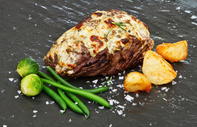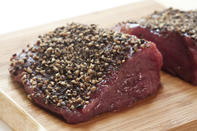Ostrich meat is low-fat red meat, rich in iron, produced in sustainable, mostly free-range farming systems. Birds are raised to about 90 kg and then processed under humane and Halaal conditions. The production of ostrich meat in South Africa follows stringent quality monitoring processes, ensuring meat can be traced back to the farm of origin.

Processing of Ostrich Meat
The farming and processing of ostriches follow a cycle, which includes a rest period of a few months after breeding. Therefore processing slows down from April to August.
Very high standards are demanded of both South African ostrich farmers and South African ostrich abattoirs, this includes human handling of animals pre-slaughter. Ostriches are prone to stress, so it is important to reduce stress prior to slaughter to prevent an increase in pH, which may lead to tough, dry meat.
Abattoirs are monitored and certified by registered veterinarians to comply with import requirements of the European Union, whereafter permits are issued by the Department of Agriculture, Forestry and Fisheries (DAFF).
According to DAFF ostriches must be placed in quarantine for at least 14 days before slaughter. These quarantine camps must be tick-free to avoid the possible transmission of Congo fever, while inoculation of ostriches against Newcastle disease is compulsory.
All South Africa ostriches must have an identification tag, with a unique code that allows the meat to be traced to a registered farm of origin. A farm must be registered for at least six months before birds can be presented for slaughter.
No growth stimulants or hormonal treatment of ostriches are allowed.
Ostrich Meat Products
The main months for the availability for fresh ostrich meat is September to March.
As their wings are small and they have flat breastbones, most ostrich meat is sourced from the legs. Ostrich meat, despite being from a bird, is classified as red meat and is, in fact, darker than that of beef.
Favourite forms of ostrich meat for local consumption are ostrich wors (sausage) and biltong (a dried and spiced meat). South African ostrich meat is exported as fillet, steaks, mince, burger patties and goulash cubes.
Other ostrich products include pre-grilled ostrich steak, ostrich trimmings, carpaccio and ostrich paté.
Fat Content of Ostrich Meat

Ostrich fillet, steak, goulash and mince are considered extra lean and have been endorsed by the South African Heart and Stroke Foundation.
Ostrich meat is extremely popular in Europe, due to its health characteristics - low in cholesterol and fat. Most of the bird’s fat is stored under the skin and in the abdominal cavity. Gender has no effect on meat yield in young ostriches but females birds tend to have more fat than males.
Studies in 2012 found that by enriching the diet of ostriches with linseed by 4% and 8%, the flavour and fat content (respectively) were positively influenced. An increase of 4% in linseed also reduced the cooking loss and increased the ratio of polyunsaturated to saturated fatty acids.
The fat content of ostrich meat is 2.8 g per 100 g of meat, significantly less compared with beef 9.3 g, turkey 7.4 g and chicken 5.0 g.
Export of Ostrich Meat
Due to the seasonal nature of fresh ostrich meat, a technique has been developed for the heat treatment of ostrich meat to allow for year-round availability. Pre-grilling of ostrich meat involves heating the core of the meat to 70°C. The portions are then frozen, in which form it is perfectly acceptable for export to the EU. Pre-grilled meat (fillets and steaks) allows for easy and fast preparation by the consumer. Ostrich meat is also available as a chilled or frozen product, as individually vacuum-sealed portions and bulk-packed.
Piet Kleyn, chairman of the Ostrich Business Chamber in Oudtshoorn, states that regular blood samples are required from farms and abattoirs. This is part of a standard monitoring programme to ensure ostriches are free from chemicals such as growth hormones. In South Africa, the ostrich industry does not use growth hormones or other chemicals banned by the EU.
By Marinda Louw
For bulk or Ostrich Meat export enquiries please use the enquiry link below.